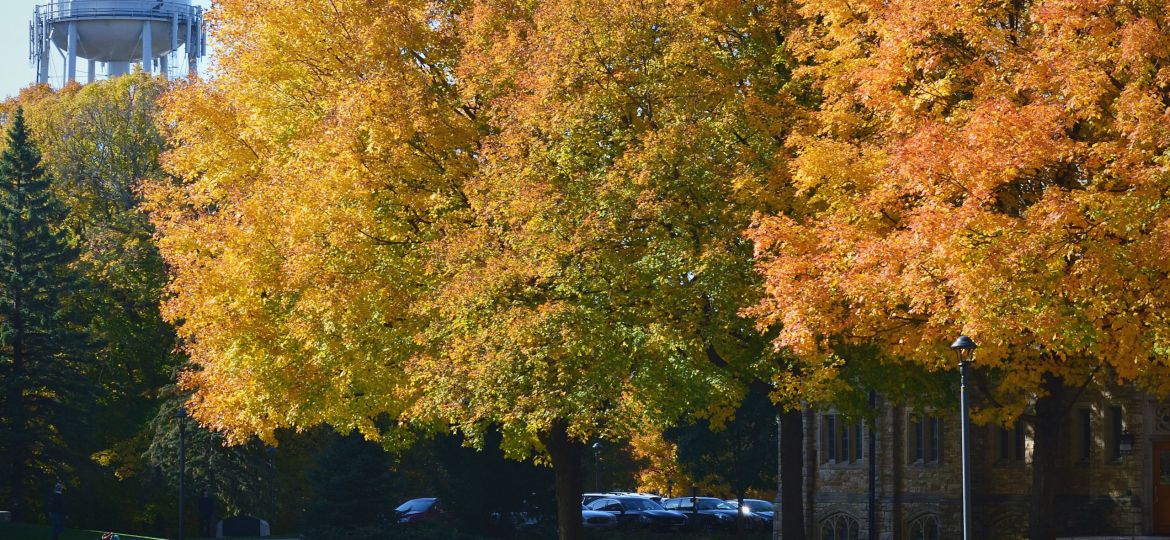
In the most recent Student Government Association (SGA) election on April 17, only 28 percent of St. Olaf students voted online — 72 percent failed to cast their votes for a candidate or executive pair. This low voter participation rate highlights a possible disconnect between students at St. Olaf and the Student Government Association that represents them.
Election Turnouts
The ongoing COVID-19 pandemic and its effects on College functions significantly altered how the election for SGA positions this spring was run. With the College closed and students scattered across the world, a completely digital election remained the only path forward for student leaders. This change invited a host of challenges for candidates and election organizers.
When classes shifted off-campus, both live candidate forums and a new door knocking initiative could not be completed. Candidates were left relying on social media marketing and networking to spread their platforms and engage with students, creating inequalities for candidates without a social media presence or without access to proper technology.
Despite these challenges and inequalities, the turnout remained comparable to that of previous elections. In fact, the percentage of participants in 2020 sits close to percentages from elections in spring 2018 and 2019 — 28 percent and 32 percent, respectively.
For many years now St. Olaf has seen a trend of low voter turnout, virus or not. The most striking indication of a decrease in student interest in SGA elections is seen in comparing the average percentage of participants from 2009 through 2017 versus the past three years.
From 2009 through 2017 (excluding spring 2011 and 2014) the average percentage of voters was around 42 percent. During this period the highest percentage of participants was 47 percent, nearly half the student body.
Over the past three years, this average has fallen to 29 percent, with all three years reporting less than 1,000 voters participating in spring elections. With a student population of over 3,000, SGA has seen less than one-third of the student body involved in electing new leaders.
So why are these more recent numbers so low?
Thoughts from Leaders
Brandon Cash ’16, associate director of student activities, believes the problem is not with overall enthusiasm or involvement from the student body, but rather something with SGA participation specifically.
“We have a very connected and involved student body which is fantastic,” Cash wrote in an email to the Messenger. “However, that engagement seems to pass by student government, even when the majority of student organizations and initiatives on-campus are sponsored by SGA.”
Many students do not know what goes on in SGA, Cash explained, and do not see how SGA could positively impact or already does affect their St. Olaf experience.
Current President and Vice-President Devon Nielsen ’20 and Ariel Mota Alves ’20 also believe the disconnect does not stem from lack of involvement on the part of SGA or the student body individually. Rather, the pair note that the disconnect may be a perception by the student body that is not indicative of the role SGA actually serves.
Mota Alves explained the dedication of the SGA team to support, both financially and otherwise, approximately 200 campus organizations and activities. Students may not understand how many activities can be traced back to SGA.
“We put movies in the Viking theater; we organize Pause Dances; we make pizza and shakes for students; we bring artists, musicians and political speakers to campus; we survey the students and bring their concerns to the Regents; we discuss and vote on issues directly concerning the student body through Senate,” Mota Alves wrote in an email to the Messenger. “So, in some way or another, most people have attended events we directly organize, or an event we help fund.”
Dean of students Rosalyn Eaton ’87 believes the purpose SGA serves is critical at St. Olaf, echoing similar sentiments by Cash and the two executives.
“SGA is meant to represent students in a variety of activities,” Eaton wrote in an email to the Messenger. “It’s SGA’s desire to provide funding for activities, speakers, concerts and events that appeal to the student body. And, frankly, students involved in SGA really want the student body to be engaged.”
Mota Alves highlighted the integration between SGA and the student body, which he identified as a noticeable difference between St. Olaf and other institutions. In large part, it is students who are allocating funds and planning events for their peers, not the College.
“I personally hope to see SGA continue to have a full agency in organizing events and representing student voices,” Mota Alves wrote.
Nielsen and Mota Alves made increasing the accessibility of SGA one of the primary parts of their campaign platform and have instituted a number of changes toward this effect.
According to Mota Alves, some of the “tangible student-centered solutions” the pair have worked on this year include publishing Senate agendas to the entire student body, starting the Senate coffee hour for the first part of the spring semester and passing resolutions to better represent the student body, such as the recent resolution that replaces Hall Senators with Class Year Senators beginning next year.
While these solutions have seen mixed levels of effect, Nielsen and Mota Alves remain hopeful that they are steps in the right direction for increasing accessibility.
Cash also acknowledges that students have attempted to convey their needs and concerns to SGA, but have often seen themselves as underrepresented in student government or that their demands have gone unheard.
“Both SGA and students have reached out to the other,” Cash wrote. “Whatever the root of the lack of engagement is, there appears to be two outstretched hands that are not meeting.”
Engagement with Senate
One way SGA engages with the student body is through Senate meetings, which are often under-attended. Senate is supposed to act as a platform to uplift and highlight student voices in dialogue with administration and elected representatives. With virtually no outside students participating in Senate, it becomes difficult to fully represent students’ perspectives.
While it can be challenging for students operating on busy schedules to attend in-person, all Senate meetings are streamed and posted on the Oleville website to watch on-demand. Archives of past Senate meetings go back many years, allowing students to return to issues previously covered.
For the purposes of this article, St. Olaf Broadcast Media compiled a streaming statistics report that tracked stream viewers from October 3, 2017 through March 10 of this year. During this time frame, no more than 16 people watched a stream of Senate live as it took place. The average is much lower — around two viewers, with many live streams running unwatched.
However, the number of viewers for on-demand streams are higher, both at peak and on average. For viewers of on-demand streams, the average is just below 23 people — a 21 person increase from live viewership.
When issues that seem to be popular among students are discussed in Senate there is a large spike in viewership for both live and on-demand streams.
At peak, 155 viewers watched the on-demand stream of Senate from Dec. 4, 2018 — double the next highest number of on-demand viewers, 73, for the stream of Nov. 6, 2018. At this particular December meeting, Senate discussed the possibility of a Plan B contraceptive vending machine on campus, a possible draw of such a high number of viewers.
A recent Senate discussion generated more interest as well. During their second virtual meeting of the spring on April 14, Senate streamed their discussion regarding a mandatory pass/fail resolution on SGA’s Instagram account. This live-stream gathered over 75 concurrent viewers — significantly higher than regular live-streams of meetings.
Whether the usual low numbers are caused by student apathy or feelings of disconnect is difficult to say. At a College with an average enrollment of near 3,000 students, less than 1 percent of students tuning into on-demand streams on average is strikingly low.
SGA remains a critical aspect of student life at St. Olaf. In addition to event programming and funding mentioned by Vice President Mota Alves above, student government is the primary connection the student body has to administration, able to affect change on a wide host of issues.
It’s important to emphasize that a disconnect between students and student government does not mean that critical issues aren’t being addressed. SGA continues to push for better representation and accessibility, and initiatives across campus, such as the Climate Justice Collective and the Collective for Change on the Hill, present to Senate as a means to get the support of this important institutional body.
Regardless, an increase in engagement remains an ongoing concern for the leaders of SGA and campus administrators. The more students engaged with government means a wider range of issues can be addressed in more meaningful ways.
“There is not a single, swift answer to turning campus engagement on its head,” Cash wrote. “This will require a change in our campus culture around engagement, a change that likely starts with communication from both [SGA] and the students they seek to serve.”
The process for increasing government engagement will take time, but the work of current executives and student leaders is moving SGA in the right direction.
peacor1@stolaf.edu
marand1@stolaf.edu















